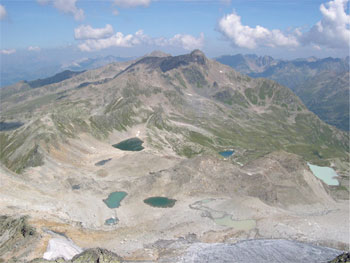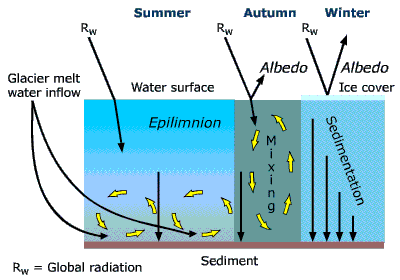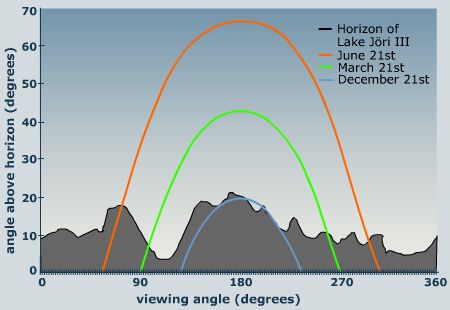 |
|
|
|
|
|
|
|
Radiation is an important ecological factor; it drives earth's climate and nearly all biological activities. Its infrared portion (near IR, wavelengths 780 nm - 25000 nm) regulates the heat budget of aquatic ecosystems, its visible portion (V, wavelengths 380 nm - 780 nm) catalyzes bio-photosynthetic and geo-photochemical reactions and its ultraviolet portion (UV, wavelengths 150 nm - 380 nm) can exert photochemical damage to bio-macromolecules (nucleic acids, proteins). Water acts as a filter for infrared (IR) radiation which is absorbed by H2O molecules, but it allows visible and UV radiation to penetrate several meters into the water column. |
|
|
|
Turbidity plays an important role for the radiation regime in many alpine lakes and rivers. Within the Jöri catchment there are small lakes with different radiation regimes. Turbid lakes, which are directly fed through the Jöri glacier, contain high concentrations of suspended erosion particles (also called glacier flour) and thus have a typical milky appearance. Clear lakes contain snowmelt and rain water and are no longer influenced by the glacier, the dark lakes are rich in ferric oxyhydroxides which cover rock surfaces along the shore. Turbid lakes reflect more radiation than clear lakes which influences in turn the heat energy regime and the times of freezing and thawing. |
1 - Small lakes with different radiation regimes in a glacier retreat catchment (Jöri, GR, CH) |
|
2 - Distribution of suspended particles (after Gabathuler 1999) |
The turbidity in lakes with glacier meltwater input varies in time and depth. The amount of "glacier flour" transported may be remarkable. It is highest on warm and sunny days reaching a daily maximum between 3 to 4 pm. Due to the higher density of inflowing meltwater it is higher in the hypolimnion than in the epilimnion. Turbidity reaches highest values after fall overturn, when mixing of the entire water column occurs. The increased particle concentration in the epilimnion results in a higher reflectivity of the lake (albedo). |
|
|
|
In mountain environments, direct incident solar radiation is often partially blocked by high peaks, which surround narrow lake catchments. For example, the duration of direct irradiance of Lake Jöri III varies from a few hours every day during summer to only a few minutes during the height of winter (Fig. 3). Blockage of irradiance not only has consequences for the irradiance regime, but also for the energy budget of the lake. It can result in longer or shorter periods of ice cover. |
3 - Sun elevation above the horizon of Lake Jöri III (after Gabathuler 1999) |
|
|
|
Solar ultraviolet radiation is a crucial environmental factor in alpine lakes because of the natural increase of UV radiation with elevation and the high water transparency of these ecosystems. In contrast to most lowland lakes, most alpine lakes have low concentrations of dissolved organic carbon (DOC). Most of it originates from aquatic organisms, from atmospheric deposits and from runoff sources from the lake catchment. Runoff carbon is a minor component in high mountain lakes if the catchments do not contain well developed soil covers. It is a major carbon source in lowland lakes, where the surrounding soil and vegetation may contribute large amounts of carbon. The irradiance flux of UV reaching a given depth within a lake depends on weather conditions and the reflectance and absorption within the water column. Radiation fluxes can change quickly with cloud cover and within short time periods, especially immediately after melting of the ice cover, which normally takes place at the end of June and July when radiation intensity is highest. Alpine aquatic organisms have developed a number of strategies to minimize UV damage:
In contrast to lowland aquatic ecosystems, productivity in alpine lakes is often highest at intermediate depths (6-9 m). Zooplankton seems to avoid surface water during the day, probably because of high UV radiation. Microorganisms present in high-radiation environments contain diverse photobiologically active compounds, which directly or indirectly absorb UV energy and thus may protect from UV-damage. Examples for such molecules can be found here. Concentrations of some photobiologically active molecules show seasonal patterns with highest concentrations during the ice free period in summer, and concentrations decrease with depth, suggesting their photoprotective role. Most benthic and planktonic primary producers and crustacean zooplankton seem to be well adapted to high intensities of solar radiation, whereas heterotrophic protists, bacteria, and viruses seem to be particularly sensitive to UV radiation. |
29 August 2011 |
||
| |
||


